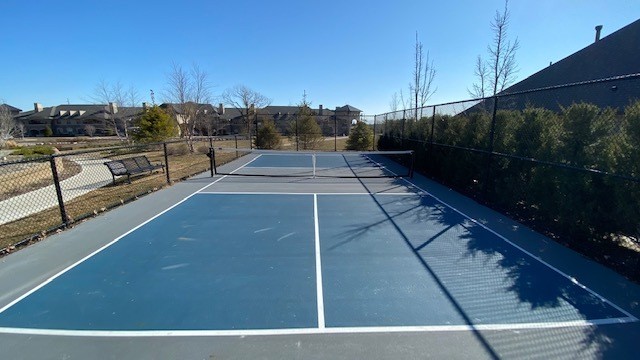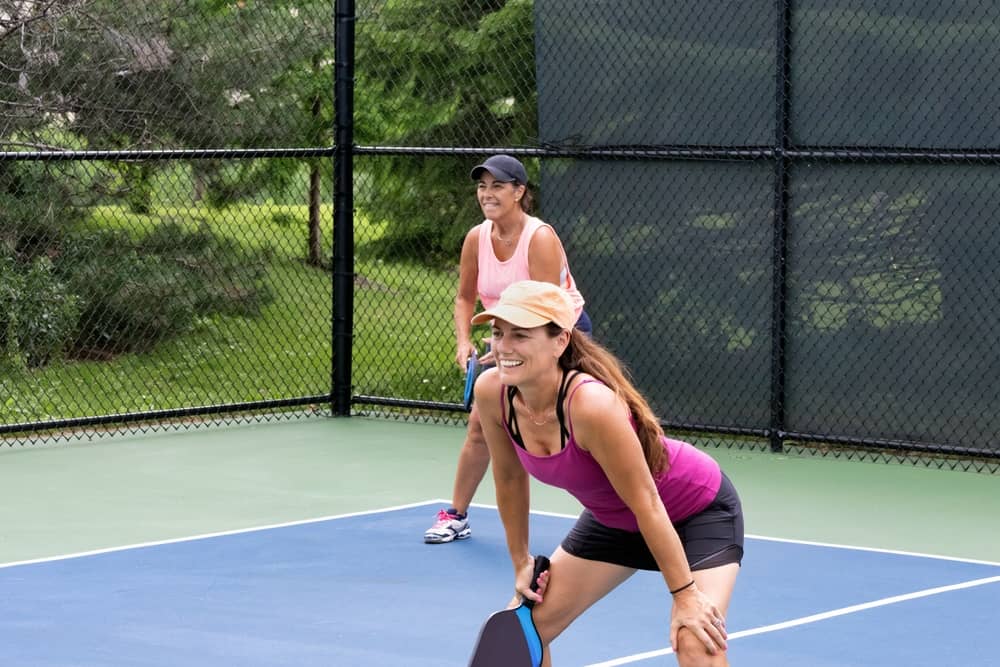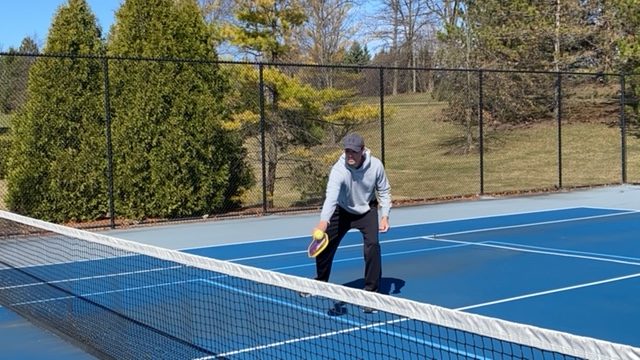Welcome to the wonderful world of pickleball! I’m a seasoned pickleball player, and I’m thrilled to introduce you to this fantastic sport, especially if you’re new to it.
Pickleball is a unique and easy-to-learn game that combines elements of tennis, badminton, and ping pong. It’s played with a paddle and a plastic ball, making it accessible for people of all ages and skill levels.
When it comes to the different surfaces for playing pickleball you might be wondering can you play pickleball on concrete?
Yes, you can play pickleball on concrete. In fact, portable nets were designed so that the game could be played on concrete driveways, parking lots or just about anywhere that has a smooth 20×44-foot concrete surface.
Pickleball is known for its inclusivity and versatility. It can be played indoors or outdoors on various surfaces, including concrete. So, if you have access to a concrete surface and are eager to try pickleball, you’re in for a treat!
In the sections ahead, I’ll dive into the benefits and considerations of playing on concrete, how to set up your own court and share insights from fellow players. By the end, you’ll be well-equipped to enjoy pickleball on a concrete court. Let’s jump in!
This paddle is the most forgiving paddle I've ever played with and has a HUGE sweet spot!
What Surfaces Can Pickleball Be Played On?
In the world of pickleball, playing surfaces can vary depending on the situation. Whether you’re stepping onto a court for the first time or just considering where to play, it’s essential to understand your options.
- Indoor Courts: Indoor pickleball courts are typically found in sports complexes, recreation centers, or gyms. They offer a controlled environment with consistent playing conditions, making them an excellent choice for players who prefer a predictable experience. These courts are often on a basketball court so the surface is wooden. Other indoor courts are made from plastic tiles.
- Outdoor Courts: Outdoor pickleball courts are usually found in parks, community centers, or residential areas. They are more exposed to the elements and come in various surfaces, including asphalt and concrete. Outdoor courts provide a refreshing change of scenery and are perfect for those who enjoy playing in natural surroundings.
- Concrete Driveway Courts: Concrete pickleball courts are a subset of outdoor courts, and are typically found on driveways. Concrete surfaces offer unique benefits such as durability and accessibility. They are known for their longevity, making them a popular choice for communities looking for a low-maintenance playing option.
Pickleball on Concrete
Now, back to our central question: Can you play pickleball on concrete? Absolutely! Concrete courts are a fantastic choice, especially if you want a stable, all-weather playing surface that can withstand the test of time. The hard, smooth surface of concrete provides consistent ball bounce, allowing for strategic and enjoyable gameplay.
As a newcomer to pickleball, you’ll find concrete courts to be an excellent starting point. They’re readily available and often free to use in public spaces, making it easy to pick up this exciting sport.
In the following sections, I’ll delve deeper into the advantages and considerations of playing pickleball on concrete, helping you make the most of this fantastic playing surface.

How to Set Up a Pickleball Court on Concrete
Creating your own pickleball court on a concrete surface is pretty straightforward and easy. Here’s a concise guide to help you get started:
- Gather Equipment: Before you begin, ensure you have the necessary equipment, including pickleball paddles, a net, and pickleballs. You’ll also need court tape, court paint or chalk for marking the boundaries.
- Measure and Mark: Accurately measure and mark the pickleball court dimensions on the concrete using masking tape or court paint. For a standard doubles court, the dimensions are 20 feet wide by 44 feet long. For singles play, the width remains the same, but the length is reduced to 22 feet.
- Set Up the Net: Use a portable pickleball net so that you have a regulation net (36 inches at the sidelines, 34 inches at the center). Ensure the net is taut and at the correct height.
- Court Boundaries: Use masking tape or paint to mark the court’s boundaries, including the non-volley zone (kitchen) and the service area.
- Prepare Playing Area: Sweep the concrete surface to remove any debris or loose particles that might affect gameplay. A clean court ensures a smooth playing experience.
- Gather Players: Invite friends or fellow enthusiasts to join you on your newly created pickleball court, and enjoy the game!
Remember, setting up a pickleball court on concrete allows you to bring the excitement of this sport to your local community or even your backyard. Whether you’re a casual player or looking to host tournaments, a concrete court offers a stable and reliable playing surface for endless pickleball enjoyment.
So, grab your equipment, mark those lines, and get ready to experience the thrill of pickleball on your concrete court!
For more on knowing if you can play pickleball on a tennis court, click the link.
Benefits of Playing on Concrete
Playing pickleball on concrete offers a multitude of advantages that make it a compelling choice for both beginners and experienced players alike. Let’s delve into these benefits:
- Durability: Concrete is known for its exceptional durability. Unlike some other surfaces that may wear down over time, concrete courts are built to last. It can withstand the elements, heavy use, and various weather conditions without significant deterioration. This means you can enjoy consistent pickleball action for years to come.
- Accessibility: Concrete courts are widespread and easily accessible. Many parks, recreational areas, and community centers have concrete pickleball courts available for public use. This accessibility ensures that you can find a place to play pickleball without having to travel far.
- Consistent Ball Bounce: The hard, smooth surface of concrete provides a reliable and consistent bounce for the pickleball. This consistency allows players to develop their skills and strategies with confidence. Whether you’re practicing your serves or engaging in intense rallies, you’ll appreciate the predictability of the concrete surface.
- Cost-Efficiency: Compared to some other court surfaces, concrete courts are often more cost-effective to build and maintain. This makes them an attractive option for communities and facilities looking to provide pickleball courts without breaking the bank.
- Versatility: Concrete courts are versatile and can be used for various sports and activities. This flexibility allows you to enjoy pickleball alongside other sports like basketball or tennis, making concrete courts a hub for recreational fun.
In summary, playing pickleball on concrete offers durability, accessibility, consistent ball bounce, cost-efficiency, and versatility. Whether you’re a newcomer or a seasoned player, these benefits make concrete courts an excellent choice for enjoying this exciting sport.
In the next section, I’ll explore some important considerations when playing on concrete surfaces to ensure a safe and enjoyable experience.
Considerations for Playing on Concrete
While concrete courts offer numerous benefits for pickleball, it’s essential to be aware of certain considerations to ensure a safe and enjoyable experience:
- Surface Hardness: Concrete is a firm surface, which can be hard on your joints, especially if you engage in lengthy play sessions. To mitigate the impact, invest in pickleball-specific shoes that provide cushioning and support. Additionally, warming up properly and incorporating stretching exercises can help reduce the risk of discomfort or injury.
- Temperature Variations: Concrete courts can become scorching hot in direct sunlight during the summer months. This can make play uncomfortable and potentially even dangerous. Consider scheduling your games during cooler times of the day or seek shade if available. Wearing light, breathable clothing and staying hydrated are also essential precautions.
- Maintenance: Regularly inspect the concrete court for cracks or uneven surfaces that could pose tripping hazards. Promptly address any issues to maintain the court’s safety and longevity. Sweeping away debris and keeping the court clean can prevent slipping during play.
- Noise Levels: Keep in mind that in addition to some pickleball paddles being noisy, concrete surfaces can be noisy as well. If you’re playing in a residential area or near noise-sensitive locations, consider the potential impact on the surroundings and fellow players.
By considering these factors and taking appropriate precautions, you can fully enjoy your pickleball experience on concrete courts while ensuring safety and comfort for yourself and your fellow players.

Maintenance and Care When Playing Pickleball on Concrete
Maintaining a concrete pickleball court is relatively straightforward but essential for its longevity and safety:
- Regular Cleaning: Sweep the court regularly to remove debris like leaves, dirt, or small stones. These can affect ball bounce and player traction. Use a leaf blower or a broom with stiff bristles for thorough cleaning.
- Repair Cracks: Inspect the court for any cracks or uneven surfaces. Cracks can expand over time, creating tripping hazards. Promptly repair cracks with appropriate concrete filler to prevent accidents and maintain a smooth playing surface.
- Pressure Washing: Periodically pressure wash the court to remove dirt buildup and stains. This not only keeps the court looking fresh but also improves safety by minimizing slippery spots.
- Surface Resealing: Depending on usage and climate, you may need to reseal the concrete surface every few years. Resealing helps protect the court from weathering and extends its lifespan.
- Net and Accessories: Regularly check the pickleball net (both portable or in-ground), posts, and other accessories for wear and tear. Replace any damaged or worn-out parts to ensure a safe and enjoyable game.
By incorporating these maintenance practices into your routine, you can keep your concrete pickleball court in top condition, providing a safe and enjoyable playing experience for years to come.
Player Experiences
Let’s hear from seasoned pickleball players who have enjoyed the game on concrete courts:
- Tom, a Passionate Player: “I’ve played pickleball on various surfaces, but there’s something special about concrete. The consistent bounce and durability of the court allow for intense rallies and strategic play. It’s also fantastic for practice sessions, as you can rely on the surface for a true reflection of your skills.”
- Lisa, a Community Organizer: “Concrete courts have been a game-changer for our community. They’re low-maintenance, easily accessible, and have brought people together. I’ve seen players of all ages and skill levels enjoy pickleball on concrete. It’s been a fantastic addition to our neighborhood.”
- Mike, a Tournament Enthusiast: “I’ve participated in numerous pickleball tournaments, and some of the best games I’ve ever played were on concrete courts. They’re versatile and can accommodate various events. Plus, the sturdy surface allows for intense matches without worrying about court damage.”
These personal experiences highlight the enjoyment and benefits of playing pickleball on concrete surfaces, reaffirming its popularity among players of all backgrounds.
Speaking of “experiences” – did you know you can play pickleball in the rain?
Alternatives to Concrete
While concrete is a great choice for pickleball, it’s worth exploring other playing surfaces:
- Grass: Grass courts offer a unique playing experience and are gentler on the joints. However, they require regular maintenance and can be affected by weather conditions. Click the link for more on how to play pickleball on grass.
- Asphalt: Asphalt courts are common outdoors and provide consistent ball bounce. They are durable but may require resurfacing over time.
- Indoor Courts: Indoor pickleball courts are often made of wood or synthetic materials. They offer controlled conditions and are ideal for year-round play.
Each surface has its advantages and considerations, so your choice should align with your preferences, climate, and available resources.
I also created this friendly guide that gives you a complete breakdown of all the differences between a pickleball court and a tennis court. The differences may surprise you.

Pickleball on Concrete – Safety Tips
Ensuring safety on the pickleball court is paramount:
- Proper Footwear: Invest in pickleball-specific shoes with good traction and cushioning to protect your feet and enhance stability.
- Warm-Up: Start each session with a proper warm-up to prepare your muscles and joints for play, reducing the risk of injuries.
- Stay Hydrated: Drink plenty of water to stay hydrated, especially when playing in warm weather.
- Respect Boundaries: Be mindful of the non-volley zone (the “kitchen”) and follow the rules to prevent accidents and disputes.
- Communication: Effective communication with your fellow players is key to avoid collisions and ensure a smooth game.
By adhering to these safety tips, you can enjoy pickleball on concrete surfaces while minimizing the risk of injuries and enhancing your overall playing experience.
Can You Play Pickleball on Concrete – My Final Thoughts
In conclusion, pickleball on concrete offers an accessible, enjoyable, and long-lasting way to embrace this fantastic sport. Concrete courts provide stability, durability, and versatility, making them a top choice for pickleball enthusiasts.
By understanding the benefits and considerations of playing on concrete, maintaining the court properly, and prioritizing safety, you’ll have countless opportunities for thrilling matches and memorable moments.
So, gather your gear, invite friends, and get ready for a fantastic pickleball experience on your concrete court. The journey awaits!
Playing Pickleball on Concrete – Related FAQs
Below are some related commonly asked questions about playing pickleball on concrete versus other surfaces.
Can you Play Pickleball on a Concrete Driveway?
Yes, in fact, driveway pickleball is one of the most common forms of recreational pickleball and my family has been setting up a court on our driveway for over seven years!
Portable nets have become lighter and carry around and easier to set up, making driveway pickleball one of the most convenient ways to introduce new people to the wonderful game of pickleball. Just grab a portable net, chalk the lines down and you’re all set!
Is Concrete Better Than Asphalt for Playing Pickleball?
Yes, concrete is better for playing pickleball on compared to asphalt because when poured properly, concrete has a smoother surface that allows the ball to bounce naturally. Asphalt tends to have a rougher surface and doesn’t give as consistent of an experience compared to concrete.
Can Pickleball Be Played on Hardwood Floors?
Absolutely! In fact, most indoor pickleball courts at rec centers or gyms are played on a basketball court, which is obviously wooden. The sealed and coated wooden court of a basketball court is perfect for indoor pickleball as long as you’re using an indoor pickleball. Indoor pickleballs are softer and slower which is best suited for indoor play on a hardwood floor.
Do Pickleballs Bounce Properly on Concrete?
Yes, most outdoor pickleballs will bounce as intended on a concrete court, especially if the court was designed for pickleball or tennis. Just make sure the concrete court area is free of debris and leaves if playing outdoors.
As long as the playing surface is smooth, you’ll have no issue with how the pickleball should bounce.
Can you Play Pickleball on Raw Concrete?
While you can play pickleball on raw concrete, I don’t recommend it for several reasons. First of all, raw concrete may not be as smooth as it needs to be because of tiny cracks or debris. Traditional outdoor pickleball courts have a layer of material to prevent long-term wear and tear.
A simple slab of raw concrete doesn’t have this layer of sealer material to prevent this.
Additionally, raw concrete is harder on your knees and joints causing more wear and tear on your body.
Is a concrete court suitable for pickleball?
Absolutely! A concrete court is considered a great playing surface for pickleball. It provides a consistent and smooth playing experience, allowing players to fully enjoy the game.
Can you play pickleball on a tennis court with a concrete surface?
Yes, if the tennis court has a concrete surface, it can be a suitable place to play pickleball. Many tennis courts are also used for pickleball, especially outdoor courts with a hard playing surface. They are virtually the same type of playing surface
Can I play pickleball on a concrete floor in a gym?
Yes, pickleball can be played on a concrete floor in a gym. The firmness and stability of concrete make it suitable for indoor pickleball courts, including those found in gymnasiums.
Can I play pickleball on polished concrete?
Absolutely! Polished concrete can be an excellent surface for pickleball. It provides a smooth playing experience while still offering good traction.
Can I play pickleball on a concrete court indoors?
Yes, indoor pickleball courts often have a concrete playing surface. Many recreational centers and dedicated indoor pickleball facilities have indoor courts where pickleball can be played on concrete.
Can concrete be used for building a pickleball court?
Yes, concrete is commonly used as a base material for building pickleball courts. It provides a solid and stable foundation for the court surface.
Are outdoor pickleball courts typically made of concrete or asphalt?
Many outdoor pickleball courts are made of concrete rather than asphalt. The hard surface of concrete offers better ball bounce and durability, making it a preferred choice for outdoor courts.

Welcome to TheVolleyLlama.com. My name is Keith, I’m just a lover of all sports that involve a racquet, net and a ball. I played competitive high school varsity tennis, love racquetball and my whole family plays pickleball regularly. I started this website to help give people like you the basics to learn these wonderful games.



